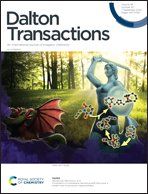Framework induced deformation modulates the photophysical properties of ZnTetra(4-pyridyl)porphyrin incorporated within a new metal organic framework, RWLAA-1†
Abstract
Porphyrin based metal organic frameworks (MOFs) have provided a broad platform through which a wide variety of light harvesting applications have been developed. Of particular interest within light harvesting MOFs containing porphyrin chromophores is the extent to which the both environment of the porphyrin and the porphyrin conformation modulate the photophysical properties. With this in mind, a new MOF (RWLAA-1) has been synthesized based on zinc cations linked by zinc(II) tetra(4-pyridyl)porphyrin (ZnTPyP) and benzene tricarboxylate (H3BTC) linkers in which the porphyrin exhibits significant conformational distortions that have a profound effect on the photophysics of the material including bathochromic shifts in both the optical (Soret and visible bands) and emission bands, reduction in the energy separation between the Q(0,0) and Q(0,1) emission bands and shorter singlet and triplet state lifetimes. These effects are consistent with the porphyrin deformation resulting in changes in the porphyrin electronic structure and excited state conformational dynamics that alter the vibronic coupling between the excited states (S1 and T1) and the S0 ground state.



 Please wait while we load your content...
Please wait while we load your content...